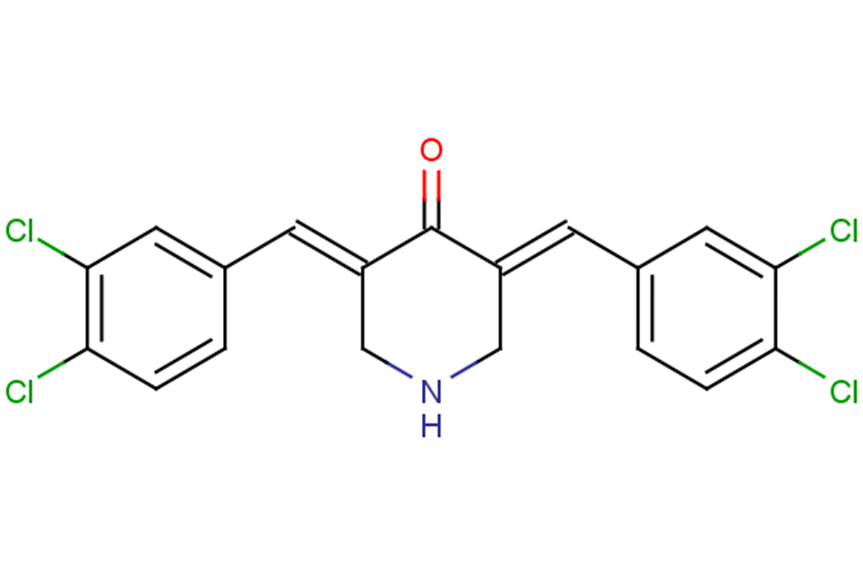
PTP1B-IN-9
CAS No. 145888-79-5
PTP1B-IN-9 ( —— )
产品货号. M22017 CAS No. 145888-79-5
PTP1B-IN-9 是一种泛素蛋白酶体系统 (UPS) 应激源,具有抗癌活性。 PTP1B-IN-9 以剂量依赖性方式降低指数生长的 HeLa 宫颈癌细胞的细胞活力,IC50 值为 2 μM。
纯度: >98% (HPLC)
 COA
COA
 Datasheet
Datasheet
 HNMR
HNMR
 HPLC
HPLC
 MSDS
MSDS
 Handing Instructions
Handing Instructions
| 规格 | 价格/人民币 | 库存 | 数量 |
| 10MG | ¥616 | 有现货 |


|
| 50MG | ¥1677 | 有现货 |


|
| 100MG | ¥2770 | 有现货 |


|
| 200MG | 获取报价 | 有现货 |


|
| 500MG | 获取报价 | 有现货 |


|
| 1G | 获取报价 | 有现货 |


|
生物学信息
-
产品名称PTP1B-IN-9
-
注意事项本公司产品仅用于科研实验,不得用于人体或动物的临床与诊断
-
产品简述PTP1B-IN-9 是一种泛素蛋白酶体系统 (UPS) 应激源,具有抗癌活性。 PTP1B-IN-9 以剂量依赖性方式降低指数生长的 HeLa 宫颈癌细胞的细胞活力,IC50 值为 2 μM。
-
产品描述PTP1B-IN-9 is a ubiquitin-proteasome system (UPS)-stressor,with anticancer activity. PTP1B-IN-9 reduces the cell viability of exponentially growing HeLa cervical cancer cells in a dose-dependent fashion with an IC50 value of 2 μM.
-
体外实验RAMB4 (0-30 μM; 48 hours) treatment produces a dose dependent reduction in the viability of HPV16-positive SiHa and Caski cells and HPV-39-positive ME180 cervical cancer cell lines respectively.RAMB4 reduces the cell viability of exponentially growing HeLa cervical cancer cells in a dose-dependent fashion with an IC50 value of 2 μM. Cell Viability Assay Cell Line:Keratinocytes, SiHa, CaSki and ME180 cells Concentration:5, 10, 15, 20, 25, 30 μM Incubation Time:48 hours Result:Produced a dose dependent reduction in the viability of HPV16-positive SiHa and Caski cells and HPV-39-positive ME180 cervical cancer cell lines respectively with minimal effects on the viability of primary human keratinocytes and with IC50 similar to the obtained with HeLa cells.
-
体内实验——
-
同义词——
-
通路Proteasome/Ubiquitin
-
靶点Proteasome
-
受体Proteasome
-
研究领域——
-
适应症——
化学信息
-
CAS Number145888-79-5
-
分子量413.1
-
分子式C19H13Cl4NO?
-
纯度>98% (HPLC)
-
溶解度In Vitro:?DMSO : 5 mg/mL (12.10 mM)
-
SMILESClC1=CC=C(\\C=C2/CNC\\C(=C/C3=CC(Cl)=C(Cl)C=C3)C2=O)C=C1Cl
-
化学全称——
运输与储存
-
储存条件(-20℃)
-
运输条件With Ice Pack
-
稳定性≥ 2 years
参考文献
1.Anchoori RK, et al. Stressing?the?ubiquitin-proteasome?system?without?20S?proteolytic?inhibition?selectively?kills?cervical?cancer?cells.PLoS One.?2011;6(8):e23888.



 021-51111890
021-51111890 购物车(0)
购物车(0)
 sales@molnova.cn
sales@molnova.cn











